Global SEO Strategy: How to Optimize for International Markets
Ready to take your website across borders? Great! But wait — just translating your content isn’t enough. To truly conquer international markets, you need a smart Global SEO Strategy. Don’t worry; it’s easier than it sounds. Let’s have fun with it!
Why Global SEO Matters
Every country is different. People use different search engines, devices, and even type in different ways. A person searching in France will look for something differently than someone in Japan. That’s where Global SEO comes in.

It helps your website rank higher in search results across countries. More visibility = more clicks = more customers!
Start with Research
Before jumping into translations, do your homework.
- Market research: Where is the demand for your product?
- Keyword research: What do people in those countries actually search for?
- Competitor analysis: What are local players doing?
Tip: Don’t assume people use Google everywhere. In China, it’s Baidu. In Russia, it’s Yandex.
Choose the Right Domain Structure
There are three main ways to set up your global site:
- Country code top-level domains (ccTLD): like website.fr or website.de
- Subdirectories: like website.com/fr/
- Subdomains: like fr.website.com
Each has pros and cons, but ccTLDs are often best for building trust in local markets.
Go Beyond Translation — Use Localization
Localization means more than just changing words. You adapt your content to the culture.
- Use local currencies
- Match time formats and measurements
- Include cultural norms and holidays
Your goal? Make visitors feel like the site was made just for them.
Use Hreflang Tags
Google gets confused without language signals. Help it out with hreflang tags.
These tiny bits of code tell search engines what language and region a page is meant for. For example:
<link rel="alternate" hreflang="fr" href="https://website.com/fr/" />
This helps avoid duplicate content and improves rankings in each region.
Simplify Navigation
Visitors should easily switch to their preferred language or country version. Make the language selector visible and easy to use.

Icons like flags can help. Just make sure they’re clickable and functional!
Speed is Key
Speed matters. Especially for users in countries far from your servers.
- Use Content Delivery Networks (CDNs)
- Compress images and files
- Choose a good hosting solution
Fast-loading pages = happy users + better rankings.
Don’t Forget Local SEO
If you’re targeting a specific city or region, local SEO also matters.
- Register your business on Google My Business (or local equivalents)
- Get listed in local directories
- Encourage reviews in the local language
These steps help you appear in map results and local searches.
Measure and Adapt
You launched your international website — hooray! But your job isn’t done.
Use tools like:
- Google Analytics
- Google Search Console
- Market-specific tools
See what’s working. Where are you losing visitors? Optimize accordingly!
Final Thoughts
Global SEO sounds big, but you can totally handle it! One step at a time.
Just remember:
- Do your research
- Pick the right structure
- Focus on localization
- Use the right tools
Reach out to the world, and they’ll reach back. 🌍

Comments are closed.